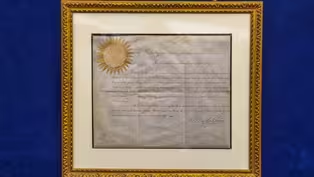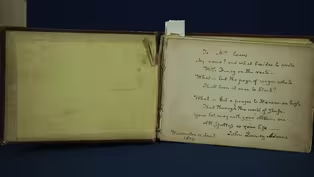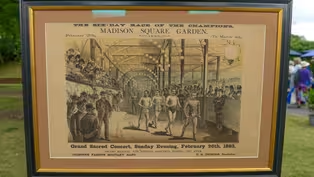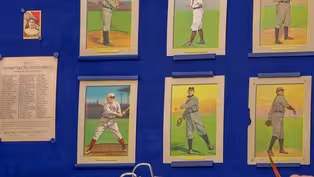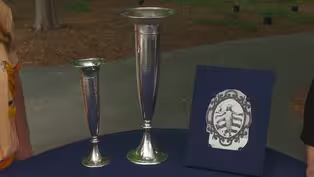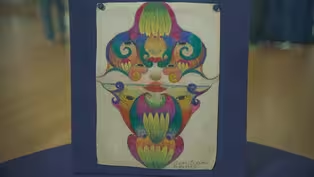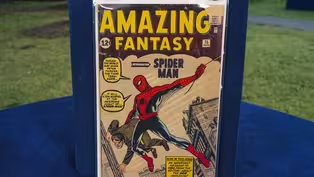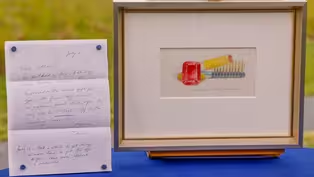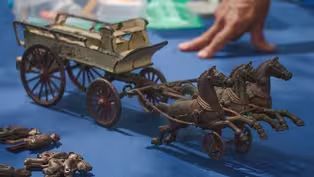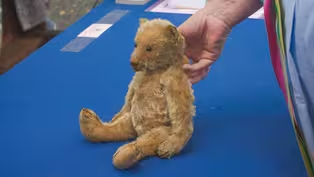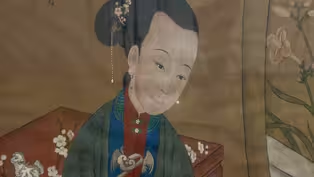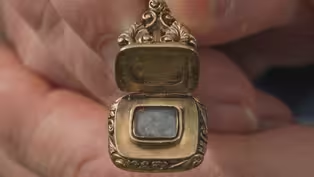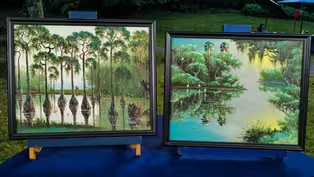
Appraisal: New Mexico Pueblo Pot, ca. 1880
Clip: Season 28 Episode 11 | 4m 3sVideo has Closed Captions
Appraisal: New Mexico Pueblo Pot, ca. 1880
In North Carolina Museum of Art, Hour 2, Ted Trotta appraises a New Mexico pueblo pot, ca. 1880.
Problems playing video? | Closed Captioning Feedback
Problems playing video? | Closed Captioning Feedback
Funding for ANTIQUES ROADSHOW is provided by Ancestry and American Cruise Lines. Additional funding is provided by public television viewers.

Appraisal: New Mexico Pueblo Pot, ca. 1880
Clip: Season 28 Episode 11 | 4m 3sVideo has Closed Captions
In North Carolina Museum of Art, Hour 2, Ted Trotta appraises a New Mexico pueblo pot, ca. 1880.
Problems playing video? | Closed Captioning Feedback
How to Watch Antiques Roadshow
Antiques Roadshow is available to stream on pbs.org and the free PBS App, available on iPhone, Apple TV, Android TV, Android smartphones, Amazon Fire TV, Amazon Fire Tablet, Roku, Samsung Smart TV, and Vizio.
Buy Now
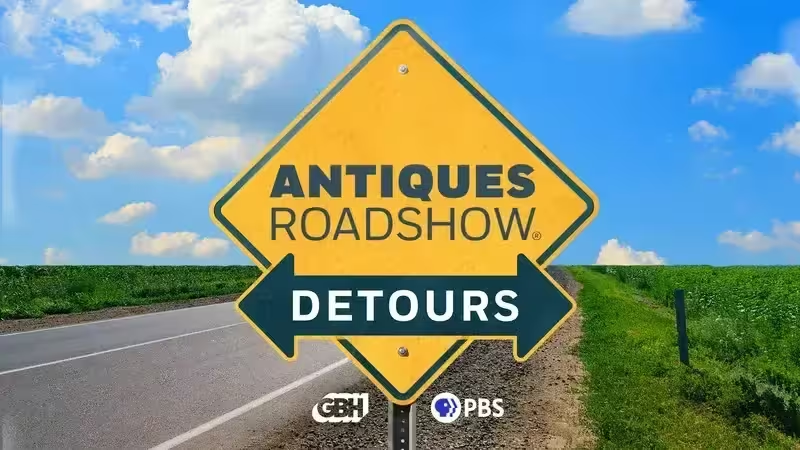
ANTIQUES ROADSHOW DETOURS
Ever wondered what happens to the treasures featured on America’s beloved ANTIQUES ROADSHOW after the cameras leave town? Host Adam Monahan tracks down the juicy afterlives of your favorite finds from PBS’s hit series.Providing Support for PBS.org
Learn Moreabout PBS online sponsorshipGUEST: My grandfather, who worked for the Norfolk and Western railroad for years, was a major collector of antiques as well as Native American art.
He's had this piece ever since I can remember.
So when he passed away, I wound up with this piece and have had it for, well, probably at least 20 years.
APPRAISER: How long do you think your granddad had it?
GUEST: He probably had it at least 60 years or better.
APPRAISER: This was made in New Mexico, right along the northern Rio Grande River.
The tribal attribution is either Cochiti or Santo Domingo Pueblo.
This is a water pitcher.
The figure is a bird, kind of with pop-eyes and a big beak.
And Native people associate themselves with the animal kingdom and the plant kingdom.
And so this bird, in a certain sense, would be an emissary to the upper world.
In the upper world, where we have clouds, we have rain, so there's sort of a form and function here.
You have a water pitcher in the shape of a bird, which is unusual.
The bird brings our prayers, our imprecations up to the heavens.
They're flying amongst these geometric devices which represent clouds.
And you'll notice they're pointing down.
All of these streaks with these little white dashes in them represent raindrops.
And then the harbinger of rain, of course, is lightning.
There's a lightning bolt coming from the upper world down to earth.
There's something really fascinating going on along the bottom.
These are deer.
The procreation of, of animal life, of human life, it all depends upon agriculture.
GUEST: Sure.
APPRAISER: So, so the deer are waiting for the grass to grow.
But every one of these deer are looking skyward.
I just think that's such a fantastic element to this pot.
GUEST: Ah.
I had not noticed that, but you're right.
APPRAISER: And then this last little character with that whimsical, wagging tail, that may well be a dog.
Dogs are exceedingly important in tribal culture.
Dogs are known as, as the first companion of man.
It's all incorporated into this complex of rainfall, agriculture, life.
These are all sacred images.
So that's very, very important to the tribe.
I don't believe that this was made for Native use.
I believe it was made as a trade item.
But the imagery is ancient, goes back a thousand years in the pueblos of New Mexico and Arizona.
Traditional Native American pottery tended to be purely for function.
The only Pueblo pottery that was made in a figural way or, or with a, a sculptural embellishment might have been for ceremonial functions, w-which this is not.
This is made to appeal to a non-Native buyer.
GUEST: Any idea when that cottage industry might have started?
APPRAISER: Second half of the 19th century, GUEST: Ah.
APPRAISER: and I would say in New Mexico, 1850 to 1870.
I think I would date this 1870 to 1890.
And Pueblo life in New Mexico in the last quarter of the 19th century was... hadn't changed too much.
There weren't automobiles running around the Pueblo.
These people were living in very much the same fashion as their ancestors did a thousand years earlier, and, and they maintained this way of life-- it was sacred.
The handle shows a tremendous amount of wear, so it was actually utilized as a water vessel.
This is, uh, ceramic, obviously, it's handmade.
The clay is a naturally harvested clay.
Probably within a hundred yards of where the lady lived, she would have had her own little clay pit.
There's a lot of craquelure all along the paint, and that would be a, an indication of its age.
I would say, on a retail basis, this would be worth approximately $6,500.
GUEST: Wow.
Wow.
Thank you, my gosh.
This was not something I was expecting for certain.
Appraisal: 1790 Appointment for 1st Supreme Court
Video has Closed Captions
Clip: S28 Ep11 | 2m 41s | Appraisal: 1790 Appointment for 1st Supreme Court (2m 41s)
Appraisal: 1840 Autograph Album with Crockett Inscription
Video has Closed Captions
Clip: S28 Ep11 | 4m 17s | Appraisal: Autograph Album with Crockett Inscription, ca. 1840 (4m 17s)
Appraisal: 1882 ‘The Six-day Race of the Champions’ Poster
Video has Closed Captions
Clip: S28 Ep11 | 3m 58s | Appraisal: 1882 ‘The Six-day Race of the Champions’ Poster (3m 58s)
Appraisal: 1910 - 1911 T3 Turkey Red Baseball Cards
Video has Closed Captions
Clip: S28 Ep11 | 5m 2s | Appraisal: 1910 - 1911 T3 Turkey Red Baseball Cards (5m 2s)
Appraisal: 1921 & 1923 Miss America Pageant Trophies
Video has Closed Captions
Clip: S28 Ep11 | 3m 2s | Appraisal: 1921 & 1923 Miss America Pageant Trophies (3m 2s)
Appraisal: 1959 Minnie Evans Crayon & Graphite Drawing
Video has Closed Captions
Clip: S28 Ep11 | 2m 48s | Appraisal: 1959 Minnie Evans Crayon & Graphite Drawing (2m 48s)
Appraisal: 1962 Marvel ‘Amazing Fantasy’ Spider-Man Comic
Video has Closed Captions
Clip: S28 Ep11 | 4m 56s | Appraisal: 1962 Marvel ‘Amazing Fantasy’ Spider-Man Comic (4m 56s)
Appraisal: 1975 Tom Wesselmann ‘Study for Still Life #61’
Video has Closed Captions
Clip: S28 Ep11 | 3m | Appraisal: 1975 Tom Wesselmann ‘Study for Still Life #61’ (3m)
Appraisal: Dent Horse-drawn Patrol Wagon, ca. 1890
Video has Closed Captions
Clip: S28 Ep11 | 1m 7s | Appraisal: Dent Horse-drawn Patrol Wagon, ca. 1890 (1m 7s)
Appraisal: Steiff Blank Button Mohair Bear, ca. 1910
Video has Closed Captions
Clip: S28 Ep11 | 1m 3s | Appraisal: Steiff Blank Button Mohair Bear, ca. 1910 (1m 3s)
Appraisal: Tang Yin Painting Copy, ca. 1930
Video has Closed Captions
Clip: S28 Ep11 | 3m 41s | Appraisal: Tang Yin Painting Copy, ca. 1930 (3m 41s)
Appraisal: Victorian Gold Memorial Watch Fob Seal, ca. 1865
Video has Closed Captions
Clip: S28 Ep11 | 1m 22s | Appraisal: Victorian Gold Memorial Watch Fob Seal, ca. 1865 (1m 22s)
Appraisal: Willie Daniels Oil, ca. 1955
Video has Closed Captions
Clip: S28 Ep11 | 2m 45s | Appraisal: Willie Daniels Oil, ca. 1955 (2m 45s)
Providing Support for PBS.org
Learn Moreabout PBS online sponsorship
- Home and How To

Hit the road in a classic car for a tour through Great Britain with two antiques experts.













Support for PBS provided by:
Funding for ANTIQUES ROADSHOW is provided by Ancestry and American Cruise Lines. Additional funding is provided by public television viewers.


